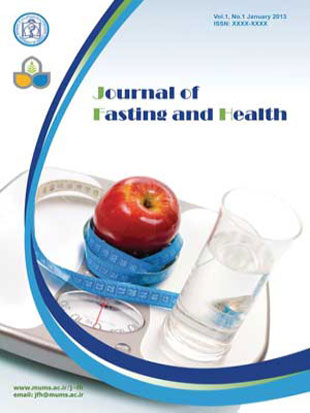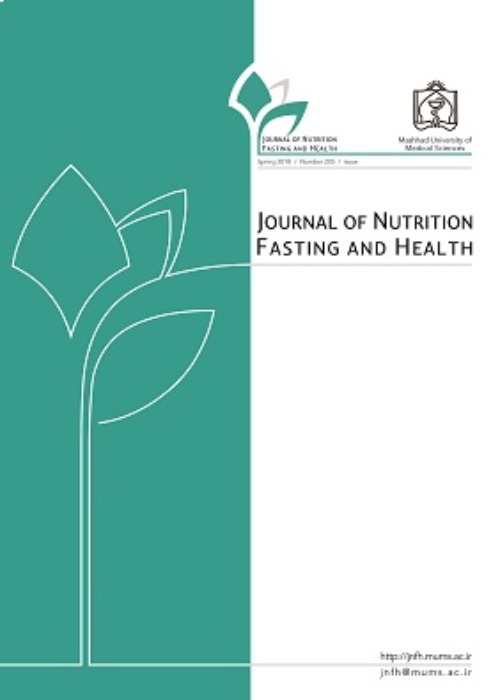فهرست مطالب

Journal of Nutrition, Fasting and Health
Volume:1 Issue: 1, Summer 2013
- تاریخ انتشار: 1392/03/13
- تعداد عناوین: 8
-
-
Page 1
-
Page 7IntroductionThe aim was to assess the effects on lifestyle and lipid profile while fasting during holy month of Ramadan.Material And MethodsAn interventional cohort study designed with 160 subjects who were fasting during Ramadan recruited from different mosques in Kermanshah. Data were collected in three stages at the beginning and at the end of Ramadan as well as one month following Ramadan using demographic and FFQ questionnaires. Blood pressure was measured and a 5 ml blood sample was collected in order to measure BUN, Creatinine, and lipid profile analysis.ResultsSignificant increases was observed in total cholesterol (P=0.02), LDL-C (P=0.001), HDL-C (P=0.001), and BUN (P=0.002) following Ramadan compared with earlier measurements. Triglyceride (TG) level decreased following Ramadan (P=0.04) but returned to the same level one month later. Systolic blood pressure increased and diastolic blood pressure decreased during fasting period. There was a significant decrease in cereals, dairy products, and meat consumption while consumption of fruits and vegetables have been increased during Ramadan (P=0.003).ConclusionOur results revealed increased levels of T-Chol and LDL-C in fasting as well as HDL-C. Increased HDL-C may prevent the side effects of T-Chol and LDL-C in healthy subjects. Given the metabolic changes that occurred during Ramadan, healthy eating and intake of low fat and low sugar diet during Ramadan are highly recommended.Keywords: fasting, HDL–C, LDL, C, Ramadan
-
Page 13PurposeThere are a few researches regarding the effects of Islamic fasting on visual system. The aim of this study was to investigate the effects of Ramadan fasting on the amplitude of accommodation (AA), near point of convergence (NPC), positive and negative fusional vergences (PFV and NFV, respectively) in visually healthy fasters.MethodsAA, NPC, PFV and NFV at far (6m) and near (40cm) were measured in 30 male students. Nutritional habits in a week before each examination visit were assessed with the Food Frequency Questionnaire (FFQ).ResultsMean age and fasting average experience were 23.9 and 10 years, respectively. AA and NPC showed significant changes (p<0.05) during Ramadan; but there was no significant difference before and after Ramadan in these parameters. NFV blur, break and recovery points at far significantly reduced in Ramadan than before (p=0.003, p=0.005, p=0.003, respectively) with insignificant compensation after Ramadan. Results showed that there was no significant correlation between changes in diet pattern and AA, NPC and distant NFV variations (p<0.05).ConclusionSome visual problems may be reported at far and near visual tasks during Ramadan; but most of the problems may be resolved after it. Some visual preparations may be needed for more effective visual activities during Ramadan; essentially for students with intensive visual tasks. Vision therapy may be suggested along with nutrient pattern improvement during Ramadan.Keywords: ocular, accommodation, convergence, binocular fusion, Ramadan
-
Page 19IntroductionRamadan is the holiest month in Islamic calendar and Muslims abstain from eating, drinking, and smoking from dawn to sunset, in which there are changes in quality of food and eating patterns. The purpose of this study was to know whether these changes provide nutritional needs, and supply all of necessary macronutrients for individuals in the month.MethodA prospective observational study was performed during Ramadan of 1429A.H (September, 2008) in Mashhad, Iran. Among 335 subjects enrolled for the study, 266 subjects met inclusion criteria. We used a semi-quantitative 302-item food frequency questionnaire (FFQ) that was self-administered and assessed the subject’s energy, macronutrient, and fiber intake over the previous three days. Dietary intake assessment was carried out one week before or after Ramadan and during the month.Results0 Data showed that the amount of energy intake and macronutrients increased significantly in women and men less than 35 years during Ramadan, and also we found a significant difference in protein intake between males and females less than 35 years old out of Ramadan time,.ConclusionThis study revealed that there was a significant increase in intake of energy and macronutrients in men and women less than 35 years that was mainly due to high consumption of carbohydrate during this month. In this study there was no change in energy intake of participants over 35 years old.Keywords: Ramadan, fasting, Iranian, FFQ, Macronutrients, Energy
-
Page 23IntroductionRamadan is the 9th Islamic lunar month during which Muslims avoid eating and drinking from sunrise to sunset. The effect of Ramadan intermittent fasting on asthma control is controversial. The aim of this study was to investigate the effects of Ramadan fasting on the spirometric variables and clinical symptoms on well-controlled asthmatic patients during Ramadan.Material And Methodsa cohort study was conducted in Mashhad, Khorasan Razavi, Iran. Twenty-nine (19 females and 10 males) well-controlled asthmatic patients aged 47 (12) years completed the study. The average duration of fasting was 26.5 days. Assessment of spirometric variables (daily peak expiratory flow, peak expiratory flow variability, peak expiratory flow home monitoring) as well as asthma clinical symptoms including dyspnea, cough, wheezing, and chest tightness were carried out.ResultsNo significant changes in clinical symptoms were reported in asthmatic patients at the end of Ramadan fasting. Among spirometric variables, only peak expiratory flow improved after Ramadan (p <0.05). There was a reduction in the mean peak expiratory flow variability from 13% at the first week of fasting to 10% at the fourth week (p <0.05).ConclusionIn well-controlled asthmatic patients, Ramadan fasting resulted in improvement in peak expiratory flow and peak expiratory flow variability.Keywords: Asthma, Daily peak expiratory flow (PEF), fasting, PEF home monitoring, Spirometry
-
Page 27IntroductionThe objective of this study was to examine the influence of sahour meal on exercise performance, and physiological responses to a 10Km Time-Trial (10KTT) at two different times of the day during Ramadan.MethodThree well-trained Muslim runners participated (age, 25±0.8years; maximal oxygen uptake, 54.87±3.45 ml.kg-1.min-1; body weight, 52.4±1.99 kg; height, 162.7±3.55 cm). Subjects ran a 10KTT on four occasions: 8.00am (Am), and 5.00pm (Pm), separated by one day rest two weeks before Ramadan (BRam) and during the second week of Ramadan (DRam). BRam, subjects consumed their usual diet. DRam, subjects consumed a standardized sahour meal containing 15.6±0.6kcal/kgBW; 2.3±0.1gCHO/kgBW; 0.6±0.0g Protein/kgBW; 0.5±0.0gFat/kgBW. During each 10KTT, the subject ran at 85%VO2max for the first two Km, and then at a self-selected speed then onwards. Blood samples were collected before the run, and at 2, and the end of 10 Km. Time to complete 10KTT were recorded. Urine specific gravity was measured before each run.ResultsThere was no difference in hydration status for the Am and Pm runs BRam and DRam. Running performance DRamAM, was better compared to the DRamPm. There were also no changes in blood glucose BRam and DRam. Serum Testosterone was highest at the end of 10KTT DRamPm when compared to the DRamAm, and was generally higher than BRam. Serum Cortisol showed no differences between the trials. All runners did not experience dehydration, lack of energy nor drop in performance DRam.ConclusionThe results from this study suggest that when athletes are provided with a balanced sahour meal, during Ramadan, they can maintain their performance.Keywords: Well, trained Muslim Runners, Exercise Performance, Physiological Responses, Sahour Meal, Ramadan
-
Page 37Ayurveda, manoeuvres mankind to head a healthy life in order to pursue four-fold bliss. With a view to combat physical and mental annoyances, classics have explicated two-fold therapeutic modalities; langhana/depletion and brihmana/nourishing. Upavasa /fasting is one among ten depletion therapies explained. It is envisioned at all three levels of Ayurvedic therapies- rational/objectively planned, psychological, and spiritual. Fasting is reckoned to be refraining from all forms of food intake for a given period, under supervision of a qualified physician. Acharya Charaka advocates fasting in diseases of milder intensity, in those due to aama (metabolic toxin), after purificatory procedures. Fasting person should avoid beautifying oneself, day sleep, sexual acts, and feasting prior and ulterior to fasting. Fasting is contraindicated in very young, elderly, emaciated, pregnant lady, and shortly after strenuous exercise. The principle avers that fasting kindles metabolic/digestive fire which, in absence of food, brings about paachana of vitiated doshas, thereby riposting health. Sound fasting ensues proper elimination of excretory wastes, clear belch, sweat, and taste for food. Benefits of fasting include lucidity of sense organs, lightness of body and mind, control of diseases, and enthusiasm. Yoga Shastra describes fasting with respect to three levels of food: physical, impressions, and associations and a means to unite three bodies: astral, physical, and causal. Ayurveda thus advocates fasting depending upon the dosha, agni, vaya, kala, and bala of the individual, as a preventive as well as therapeutic modality.Keywords: Ayurveda, fasting, depletion, preventive, therapeutic


